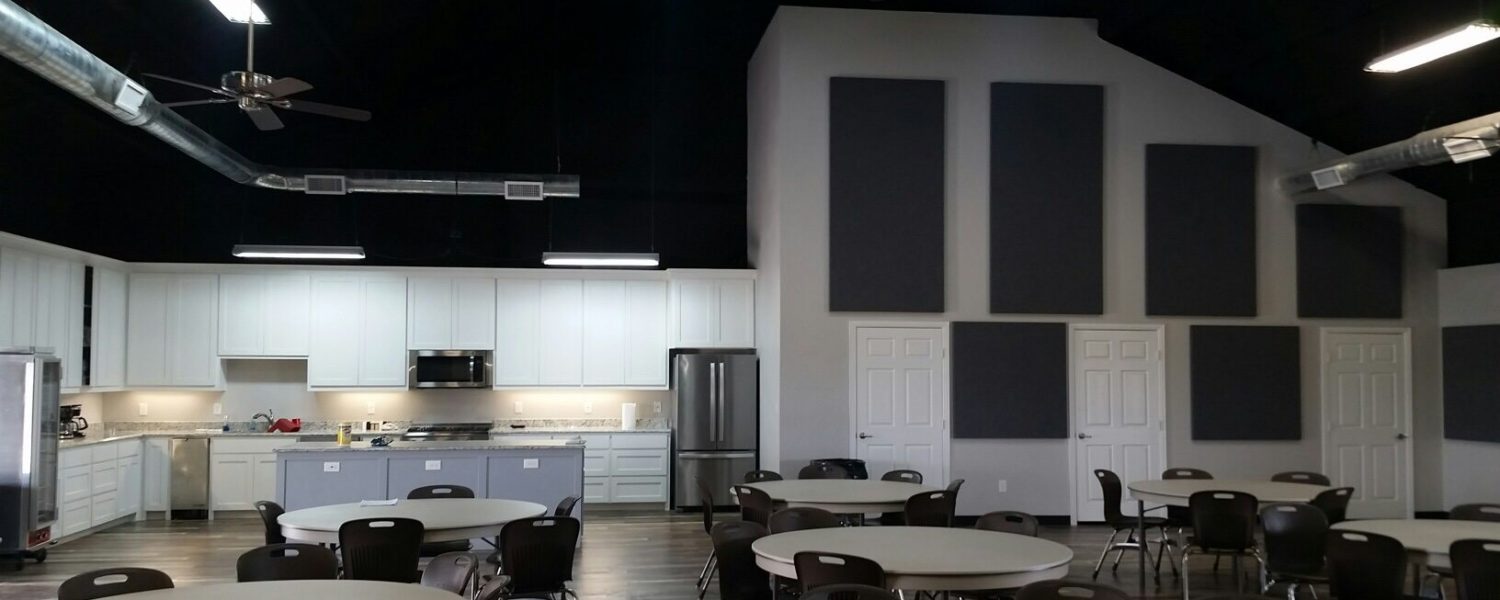Houses of worship are multi-purpose spaces designed to bring communities together. It’s important for people to be able to clearly hear speakers, each other, and the music to help build that connection. Churches also have many rooms that serve different purposes.
Each of these spaces pose different acoustical challenges, and finding solutions depend on the details of how your space is constructed and what your specific goals are. This article will go over some high-level strategies that can be implemented for common issues.
CHURCH ACOUSTICS BASICS
The main problem with church acoustics is that there are numerous hard and reflective surfaces, with little sound absorption in the space, that cause the space to have a lot of echo and reverb issues. In spaces that are so large and lack acoustic material, the sound quality becomes poor, which leads to speech and music being hard to understand clearly.
THE SANCTUARY
Finding the right acoustics in a church sanctuary is a delicate balance. In the sanctuary, you’re most likely concerned with speech and music quality, but the desired reverberation time for speech is different than it is for music.
In simple terms, reverberation time refers to how long sound continues to carry and bounce off the walls of a room. Long reverberation times can be great for music because lingering notes help to increase the enjoyment of harmonies. That’s why singing in the shower is a thing!
However, for speech clarity, short reverberation times are ideal, as you don’t want reverberant noise or echoes to muddy up what you’re trying to say. Kind of like how it’s impossible to focus when you get bad feedback on a video call or walkie talkie. But when reverberation times get too short, it can give the sense that you’re singing or praying alone, which is definitely not something we want in a house of worship.
Although these things seem to be at odds, it is possible to find the sweet spot so your acoustics work for both speech and music. Do this by finding the right combination of acoustical treatments and a quality sound system. RT60 refers to the time it takes sound to decay by 60 dB after the source of sound stops.
For example, a recording studio would want a very short RT60 at about half a second, but a symphony would want a much longer RT60, up to 2.5 seconds. Typical churches fall somewhere in the middle; you want the RT60 to be somewhere between 1.5 and 2 seconds. That said, a large cathedral could have a bit higher RT60 to help the room feel more “live;” however, you still don’t want to exceed 2.5 seconds.
Here are a few tips to help you find that sweet spot.
- Apply fabric-wrapped panels to the walls and ceiling.
- Find the right orientation and placement of your loudspeakers. They should be placed centrally and directed towards the audience. Try situating them so there is minimal overlap of coverage, while still providing an even volume to your audience. Try to avoid speakers being pointed at blank walls, as the sound reflection can disrupt the sound quality. Installing acoustic panels on the back walls will help with this problem.
- Find ways to physically elevate people singing or speaking above the congregation. This helps with sound being distributed evenly and clearly so you can be easily heard by the back row without being too loud for people in the front. In addition, it helps to engage the congregation when they can see you from anywhere in the audience.
- If you can, try to avoid irregular room shapes like deep balconies or alcoves. It’s easier to control sound inside a space with a simple layout.
FELLOWSHIP HALLS
Fellowship halls are a lot like restaurants. They tend to be larger rooms with a lot of hard surfaces that we like to stuff full of people. Small groups form and if the acoustics aren’t controlled, everyone starts raising their voices to be able to talk over the background noise.
Use acoustic panels all along the walls to help absorb the sounds of so many people speaking to make it easier to hear each other. Depending on the room, you may also want to look at installing acoustic panels on the ceiling.
BIBLE STUDY ROOMS
Bible study rooms should be thought of like a conference room in office soundproofing. You want to make sure the people inside can hear each other clearly and you don’t want to be disrupted by outside noise.
Start by applying acoustic sound panels to at least two adjacent walls to dampen the path of sound bouncing off of each wall.
These rooms are smaller, so you can typically follow the 40% Rule. Multiply the length and width of a room to determine the room’s square footage. Then multiply that by 40% to get how many square feet of panels you should install.
Depending on the size of the church or number of activities and services you provide, you may also want to take steps to soundproof your Bible study room and better understand how to reduce echo in a room.
The best way to do this is by identifying gaps in the room that let sound leak in or out, usually the doors or windows. Apply door soundproofing or soundproof window treatments to these areas to seal them up and keep out disruptions. Having a soundproof ceiling is also an important part of this process.
Houses of worship are uniquely beautiful structures that adapt to the community they are in. Inside people find peace, reflection, and community.
Good sound quality is one of the secrets operating in the background. You often won’t notice the acoustic treatments, but you sure would notice if they weren’t there!
This information is courtesy of Second Skin Audio, which was founded on the simple idea that people deserve the best quality products at a great value. Their products are engineered to stand the test of time, providing you with the best noise and heat insulation in the world, www.secondskinaudio.com.












